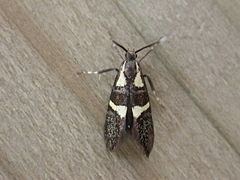Rank Species | Order Butterflies and moths | |
 | ||
Similar Butterflies and moths, Esperia, Achyra nudalis, Esperia sulphurella, Aporodes floralis | ||
Esperia oliviella is a species of gelechioid moth from Europe and the Near East. In its superfamily, it is placed in the genus Esperia within the subfamily Oecophorinae of the concealer moth family (Oecophoridae). Some authors, in particular those that follow a "splitting" approach to gelechioidea systematics and taxonomy, recognize Dasycera as an independent genus. The present species is thus not infrequently listed as Dasycera oliviella; indeed, it is (under its junior synonym Tinea aemulella) the type species of Dasycera.
Description and ecology
The wingspan is about 15 millimetres (0.59 in). At a casual glance, this species resembles its widespread relative E. sulphurella, being largely black, with a white band half-way across the thick antennae and yellowish forewing markings. Of these, the band across the midwing is not interrupted however, and the proximal lengthwise mark is a shorter triangle rather than a long streak. After eclosion and some time thereafter, E. oliviella also has a pronounced purplish sheen which is far less conspicuous in E. sulphurella even if freshly eclosed.
It inhabits old-growth woodland. Though not generally uncommon, at the periphery of its range it is a rare sight. For example, in the UK its only significant populations are in the south and southeast of England, the regions closest to the European continent. Adults are on the wing around June and July (depending on locality) and are diurnal, though they avoid the hot period around noon. The caterpillars feed on rotting wood, especially of hazels (Corylus), blackthorn (Prunus spinosa) and oaks (Quercus).
